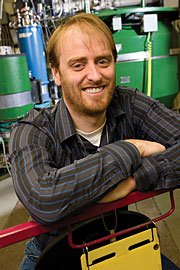- Number 351 |
- November 28, 2011
Andy Christianson finds cozy spot in neutron scattering field

ORNL's Andy Christianson.
Whether climbing mountains in Peru or using the neutron scattering beam line at HFIR, Andy Christianson sees both as an “expression of wanderlust.” Perhaps its Christianson’s attitude toward science that led him down a path of exploration, which led to the International Union of Pure and Applied Physics Young Scientist Prize (Structure and Dynamics of Condensed Matter).
At 38, Christianson’s main interest lies in understanding fundamental physical properties of materials. Assuming scientists can understand a material, they can start thinking about creating materials with new and potentially more useful properties.
Most of what Christianson works with he finds interesting, but he admits that studying iron-based superconductors was an especially fun and unique experience.
“It was the first time I was involved in a field where the competition was so stiff that you had to keep pounding and pounding, otherwise, someone else was going to do the same thing,” he said.
Christianson finds both magnetism and superconductivity appealing, and since iron-based superconductors have both properties, he says they satisfy his intellectual curiosity. Armed with a scientific admiration for what neutrons can tell us, Christianson studies materials using the neutron scattering beam lines at SNS and HFIR.
“A unique feature of a neutron is it’s a way to probe both the structure and dynamics of a material,” Christianson said. “A neutron also has a magnetic moment so that it scatters off the magnetic properties of a material. Together these characteristics make neutron scattering one of the most powerful ways to look at the magnetic properties of a material.”
While Christianson credits his collaborators and scientific technique for his successes, he also pays tribute to the ORNL environment and people.
“Working here has been wonderful,” he said. “It was a really important step for me to come to this environment and to neutron scattering. Suddenly I had a whole group of experts to work with and learn from. I’ve grown exponentially since I’ve been here.”
Even though Christianson, ORNL condensed matter physicist, was completely surprised by the award, he was equally ecstatic. “It’s very gratifying to have that recognition,” he said. “It makes me grateful for collaborations I’ve had in recent years that led to this award. Without that, I wouldn’t have done anything.” — by Emma MacmillanSubmitted by DOE's Oak Ridge National Laboratory
